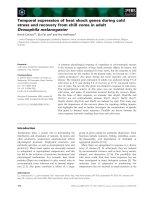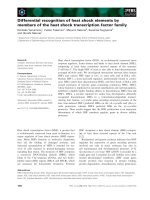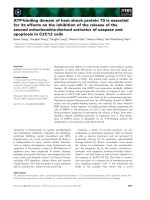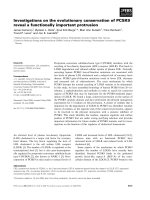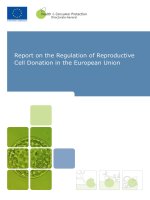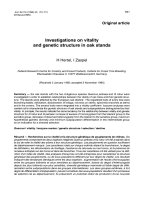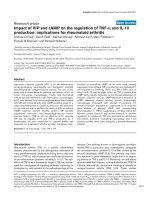Investigations on the roles of ubiquitin in the regulation of heat shock gene HSP70B 3
Bạn đang xem bản rút gọn của tài liệu. Xem và tải ngay bản đầy đủ của tài liệu tại đây (4.37 MB, 198 trang )
1
Chapter 1: Introduction
1.1 The Process and Mechanisms of Transcription
1.1.1 Introduction to Transcription and the Transcriptional Machinery
Transcription, the process by which RNA is synthesized from a Deoxyribonucleic Acid (DNA)
template, is one of the most fundamental processes in a cell. If follows several stages first of
which is the assembly of a “preinitiation complex”. This complex drives transcription from the
initiation stage to elongation stage where most of the preinitiation complex is released from the
active complex. After elongation is complete, post-processing of the RNA product occurs and it
is exported from the organelle where it was synthesized (Hahn, 2004).
The proteins that comprise a cell’s core transcriptional machinery, the Ribonucleic Acid
Polymerase (RNA Polymerase), are strongly conserved within Kingdoms. Indeed, five subunits
of RNA polymerase are known to be conserved even between Superkingdoms Prokaryota,
Archaea and Eukaryota while the latter two share even an even greater number of conserved
subunits. These subunits are classified in Eukaryotic RNA Polymerase II as Rpb1, Rpb2, Rpb3,
Rpb6 and Rpb11 (Young, 1991).
2
In Super Kingdoms Prokaryota and Archaea, there exists only one RNA Polymerase while in
Super Kingdom Eukaryota, three RNA Polymerases have been identified. RNA Polymerase I
transcribes Ribosomal RNA (rRNA) save for 5S rRNA (Russell and Zomerdijk, 2006) which is
the purview of RNA Polymerase III. RNA Polymerase III also transcribes Transfer RNA (tRNA)
and other Short Nuclear RNAs (snRNA) (Dieci et al., 2007). RNA Polymerase II however is
perhaps the widest studied as it transcribes Messenger RNA (mRNA) in the nucleus (Woychik
and Hampsey, 2002). Despite the fact that Eukaryotic RNA Polymerase is comprised of far more
subunits than that of Prokaryota and Archaea, the majority of subunits share functional if not
structural homology and are thought to share the same basic mechanisms of function and
regulation (Ebright, 2000).
1.1.2 The Eukaryotic Transcriptional Machinery
RNA Polymerase II typically comprises of about a dozen subunits although the exact number of
which varies from organism to organism. Of these subunits, designated as “Rpb”s (Repressor of
RNA Polymerase B) in modern parlance, Rpb1 and Rpb2 are usually the core catalytic
components of RNA Polymerase II (Cramer, 2004). This catalytic core, while necessary for
RNA synthesis, is in and of itself insufficient for transcription to proceed. Rather RNA
Polymerase II has no actual ability to recognize promoter DNA. It relies on the assembly of
various other factors to give it specificity and the ability to bind template DNA. Specifically the
Rpb4/7 complex and general transcription factors are also necessary for the initiation of
transcription from promoter DNA (Edwards et al., 1991).
3
As DNA in Eukaryotes is found packed in chromatin and thus inaccessible to the transcriptional
machinery, gene-specific transcription factors must bind proximally to the site of initiation and
recruit the factors necessary to modify the chromatin structure before transcription can begin
(Cosma, 2002). Assembly of this “preinitiation complex” marks the beginning of the
transcription process and starts when the TBP (TATA-binding protein) component of TFIID
binds with a promoter sequence, such as “TATA” in yeast. This is followed by other general
transcription factors like TFIIB, TFIIE, TFIIH and TFIIF which is the general transcription
factor directly bound to RNA Polymerase II (Reinberg et al., 1998).
4
Despite the fact that the preinitiation complex is fully assembled after this stage, it remains in an
inactive state until a conformational change occurs in the template strand to place the coding
DNA in the “catalytic cleft” of the RNA polymerase II complex. After the synthesis of the first
30 or so bases, RNA polymerase II is thought to release its contacts with the rest of the
transcription machinery and leaves the core promoter region to enter the stage of RNA
elongation (Wang et al., 1992).
This “release” of the transcriptional machinery by RNA Polymerase II is mediated by the
phosphorylation status of its carboxy-terminal domain (CTD). RNA Polymerase II has a
5
repeating Tyr-Ser-Pro-Thr-Ser-Pro-Ser sequence which is unphosphorylated in the initiation
stage of transcription. Phosphorylation by a kinase of this CTD signals the disassembly of the
preinitiation complex and the progress of transcription into the elongation stage. Phosphatases
recycle phosphorylated RNA Polymerase II after termination phase for use in further rounds of
transcription (Murray et al., 2001). The phosphorylation status of the RNA Polymerase II CTD
also has a role to play in the processing of mRNA. It is implicated in several phenomena such as
5’ cap addition, 3’ poly-A tail synthesis and the splicing of introns (Proudfoot et al., 2002).
Many of the released general transcription factors, termed the Scaffold Complex, remain at the
site of initiation; a phenomena which can be used to mark transcriptionally active genes. This
allows the cell to circumvent the arduous process of reassembling the initiation complex for
subsequent rounds of transcription by using these general transcription factors to aid in the
recruitment of the remaining factors necessary to begin the next round of transcription
(Yudovsky et al., 2000).
The Rpb4/Rpb7 complex is also necessary for proper transcriptional activity. Rather than process
RNA or binding to DNA, it is thought that the Rpb4/7 complex’s role in RNA Polymerase II is
that of a “clamp” to bind RNA and to contribute to the stability of the RNA Polymerase II
complex as a whole (Cramer et al., 2000). However, not all RNA Polymerase II complexes
necessarily contain the Rbp4/7 complex, rather subunit composition of the polymerase is
dependent on several factors (Kolodziej et al., 1990). These include growth conditions (Choder
and Young, 1993) and the transcription factors associated with a particular promoter (Xue and
Lehming, 2008).
6
1.2 The Mediator Complex
1.2.1 Introduction to the Mediator Complex
Along with RNA Polymerase II and the general transcription factors, another critical component
of the Eukaryotic transcriptional machinery is the Mediator Complex. The first inklings that such
a complex existed originated in biochemical experiments that attempted to reconstitute an active
transcriptional machinery in vitro. While the general transcription factors and RNA Polymerase
II were sufficient to drive promoter-targeted gene expression, they could not replicate a cell’s
ability to respond to activators or repressors (Hampsey and Reinberg, 1999). Further experiments
identified the Mediator complex in the yeast Saccharomyces cerevisiae (Thompson et al., 1993).
Many of these components had already been identified as transcription factors in various genetic
screens and thus many of the designations of yeast mediator bear names that are a legacy of this
era. For example several yeast mediator components are designated as “Srb”s for “Suppressor of
RNA Holoenzyme B”; others were likewise named for the identification methods used (Myers
and Kornberg, 2000) or apparent role in cellular regulation such as Gal11 (Carlson, 1997).
The human Mediator Complex subcomponents were thus subsequently isolated in various
biochemical reactions in vitro by identifying the proteins necessary to restore activator driven
transcription of a fully reconstituted RNA Polymerase II and general transcription factors (Sato
et al., 2003). Due to this, Mediator is classified as a coactivator of transcription although recent
evidence is emerging that challenges this classical view and asserts that Mediator is as fully
involved in transcription as a traditional general transcription factor (Taatjes, 2010). Unlike RNA
7
Polymerase II, Mediator is absent from Prokaryotes and Archaea. Furthermore, only eight
Mediator subunits are known to be conserved from Saccharomyces cerevisiae to Homo sapiens
(Rachez et al., 2001). This is not too large a surprise as the general transcription factors
themselves are also absent in Prokaryotes and only a few analogues have been identified in
Archaea (Taatjes, 2010).
1.2.2 Structure and Function of the Mediator Complex
The Mediator Complex originally isolated in S. cerevisiae has 21 subcomponents while
mammalian Mediator has a little over 30 (Tomomori-Sato et al., 2004). These subunits form
three distinct modules that undergo significant conformational changes upon binding to RNA
Polymerase II or its CTD portion. These have been termed the “head”, “middle” and “tail”
modules and each has their own role to play in the function of Mediator (Chadick et al., 2005).
The head module is the most evolutionarily conserved and is chiefly concerned with binding
RNA Polymerase II. The middle module has two submodules each with a contrary role. The
Med9 submodule is involved in repression while the Med10 submodule is involved in the
activation of genes. These allow the middle module to respond to signals even after binding to
RNA Polymerase II. The tail module mediates binding with DNA-bound transcription factors
and thus is the module most associated with Mediator’s classical role in transcription (Woychik,
et al., 2002).
The Cdk8 submodule is known to transiently associate with the Mediator Complex. It is
comprised of Cdk8, Cdk11, Cyclin C, Med12, Med13 and splice variants of the latter two
8
Mediator subunits (Sun et al., 1998). Similar to the middle Mediator module, the Cdk8
submodule can act to both repress and activate transcription. Initial studies indicated that Cdk8-
containing Mediator could not initiate transcription because Cdk8 can negatively affect
Mediator’s ability to both recruit RNA Polymerase II to the promoter and activate RNA
synthesis (Knuesel et al., 2009).
Along with its global effect on transcription, Cdk8 is also implicated in gene-specific repression.
The Cdk8 submodule, particularly the Med12 subunit, activates the G9a histone
methyltransferase. This catalyses methylation of H3K9 which typically leads to restricted access
to chromatin. However this only represses a particular subset of neuronal genes rather than a
general decrease in transcription (Ding et al., 2008).
The Cdk8 submodule’s positive role in transcription follows a similar pattern. Cdk8 can function
as an H3S10 kinase to create a permissive chromatin environment for the assembly of
transcriptional activity (Cheung et al., 2000). A link to cancer has recently been established as
Cdk8 is a positive factor for the activation of certain p53 regulated genes such as p21 and HDM2
(Donner et al., 2007).
In contrast to the general transcription factors, Mediator lacks the ability to bind to template or
promoter DNA. As was alluded to in how it was originally characterized, Mediator has a high
affinity for DNA-binding transcription factors and is thus recruited to various regulatory sites in
the genome during transcription. Indeed, there is evidence in yeast that Mediator subunits
localize to promoters on a genome-wide scale (Zhu et al., 2006). This is the origin of its name as
9
Mediator was proposed to be the bridge that mediated binding between promoter-specific
transcription factors and the general transcription factors (Ryu et al., 1999).
10
1.3 The Ubiquitin Proteosome System
1.3.1 The Discovery of the Ubiquitin Proteosome System
With the discovery of the lysosome in the 1950s, contemporary scientists believed that
proteolysis of cellular proteins were localized in this organelle (de Duve, 1953). It was logically
consistent that proteases were not only sequestered from their substrates by a membrane but that
they required a radically different environment from the cytoplasm in order to function.
Otherwise a protease would indiscriminately degrade its substrates. In addition the ability of the
lysosome to perform autophagy (Ashford et al., 1962) on smaller vesicles further strengthened
the notion that while proteins were in a dynamic state of synthesis and degradation (Simpson,
1953), these activities were confined to very particular organelles specifically designed for such
purposes (Mortimore et al., 1987).
This view held for a time but with increasingly sophisticated tools for investigation into cellular
phenomena, various observations could not be accounted for solely by the activity of the
lysosome. For one, cellular proteins have wildly different half-lives and the stability of a given
protein can be altered due to the status of the cell (Goldberg et al., 1976). This is patently
inconsistent with the notion that the lysosome was supposed to be the organelle that
indiscriminately degraded proteins through autophagy, a process that did not allow for selective
proteolysis. Added to that was the observation that different drugs inhibiting protein degradation
did not have a uniform effect across all protein populations (Knowles et al., 1976). Yet another
piece of evidence that contradicted the notion that the lysosome was the sole effector of protein
11
degradation was that proteolysis required energy in the form of Adenosine-Triphosphate (ATP)
and could be all but completely inhibited by the lack thereof. This was not consistent with
passive degradation in the acidic confines of the cytoplasm which would not require ATP
expenditure (Segal et al., 1974). The effectiveness of ATP depletion on the reducing the
degradation of proteins also implied that the lysosome was not the chief organelle that degraded
proteins as lysosome inhibitors had an inconsistent effect on protein stability. To account for this
property of lysosome inhibitors, it was theorized that the variation in protein stability in the cell
was due to the different binding affinities of proteins for the lysosomal membrane. However this
proved to be true only for a relatively small proportion of proteins (Müller et al., 1981).
A strong piece of evidence comes from an experiment that demonstrated a significant difference
in the rate at which intracellular and extracellular proteins were degraded. Living macrophages
with Tritium-labeled leucine were placed in the same media as dead macrophages labeled with
Carbon-14 leucine. By using radiation as a proxy measure it was possible to observe the rate of
degradation of both populations of proteins. Not only did the extracellular proteins localize to the
lysosome for destruction, it was found that lysosomotrophic agents which interfered with the
activity of the lysosome only impeded the degradation of extracellular proteins. From this it can
be concluded that at least two separate forces are at work in the degradation of proteins rather
than the lysosome alone (Poole et al., 1977).
Another significant milestone was an experiment where mutated haemoglobins mimicking
known diseased forms were rapidly degraded in rabbit reticulocytes which lacked lysosomes
(Rabinovitz et al., 1964). This led to later experiments where a crude extract of reticulocytes was
12
demonstrated to selectively degrade abnormal haemoglobin with the addition of ATP and this
degradation occurs at a neutral pH rather than the acidic pH of the lysosome (Etling and
Goldberg, 1977).
Initial fractionation of this crude extract through anion-exchange chromatography yielded two
fractions, the flow through and the elute. It was found that neither fraction alone could catalyze
the specific degradation of misfolded haemoglobins observed in the crude extract. This
suggested that whatever was in the extract, it was a complex of at least two proteins instead of a
single protein with protease activity which was commonly thought of at the time as the typical
form of a protease (Ciechanover et al., 1978).
Further purification of the flow through revealed an 8.5kDa, protein that was necessary for the
degradation reaction to occur. Dubbed “ATP-dependant Proteolytic Factor 1” (Apf-1), chains of
several units of this protein was found to be covalently conjugated to substrates of the
degradation reaction and that this reaction required the expenditure of ATP. The conjugation of
this protein was also shown to be reversible (Hershko et al., 1980). This protein was soon
identified as ubiquitin, a 76 amino acid protein that had already been discovered but heretofore
had no known physiological function (Wilkinson et al., 1980). It was thought to be well
conserved through all Kingdoms of life; ubiquitin is so named due to the fact that it is ubiquitous
to all living tissue and known life forms. However later studies found that ubiquitin is present
only in Eukaryotes but is indeed ubiquitous to all eukaryotic cells (Goldstein, et al., 1975).
13
With the characterization of ubiquitin, it became possible to use ubiquitin as an immobilized bait
protein to fish out the components of the ubiquitin ligase. Isolation of the E1 Ubiquitin
Activating Enzyme, E2 Ubiquitin Conjugating Enzyme and the E3 Ubiquitin Ligase resulted in
the Nobel Prize for Chemistry being awarded to Ciechanover and colleagues in 2004 (Hershko,
et al., 1983). The notion that it is the ubiquitin moiety that signals the destruction of proteins
answered the key criticisms leveled against the Lysosome hypothesis. The next question that
needed to be answered was what else was there is the elute fraction of the reticulocyte crude
extract that was necessary for proteolysis.
Various experiments found that ATP hydrolysis was also needed for proteolysis of ubiquinated
proteins aside from the already characterized requirement in the process of ubiquitin ligation
(Hershko, et al., 1984). When the 26S proteosome was finally isolated from the rabbit
reticulocyte extract, it was unlike most other characterized proteases at the time. It was massive
at around 1.5MDa (Hough et al., 1986).
1.3.2 The Structure and Function of the 26S Proteosome
The 26S proteosome is now recognized as one of the main complexes involved in intracellular
degradation of ubiquitinated proteins. Following its initial discovery, the full 26S complex was
found to have 31 subunits and can be up to 2.5MDa in size depending on the association with its
various subcomponents. Originally named for the sedimentation coefficient at which it
14
precipitates during density-gradient centrifugation, it is now known that this nomenclature is
somewhat inaccurate for the 26S proteosome, as mentioned, can vary in size (Tanaka, 2009). It
has two main sub-complexes; the 20S Core Particle and the 19S Regulatory Particle which can
exist in association with each other as the 26S proteosome or independently in both the cytosol
and nucleus (Peters et al., 1994). The former is an ATP-independent enzyme complex which is
responsible for the catalytic destruction of proteins, able to cleave the carboxy-terminal side of
hydrophic, acidic and basic residues of its substrates (Eytan et al., 1989). The 20S Core Particle
has a structure not unlike a barrel with four heptameric rings with a pair of the structural α rings
sandwiching a couple of the catalytically active β rings. This arrangement allows the α rings to
deny access to the proteases in the β rings, the regulation of which is handled by the 19S
Regulatory Particle (Smith et al., 2007).
The 19S Regulatory Particle has often been likened to a “lid” that keeps the 20S catalytic core
safely sequestered from any stray proteins. It has 19 subunits divided into two distinct sub-
complexes; nine in a “lid” sub-complex and ten in a “base” sub-complex. Of these only six
subunits in the base have ATPase activity (Rpt1-6), the other four in the lid (Rpn1, Rpn2, Rpn10
and Rpn13) and the nine in the lid sub-complex Rpn3, Rpn 5-9, Rpn11, Rpn12 and Rpn15) do
not (Hoffman et al., 1992). As its name implies, the 19S Regulatory Particle is responsible for
the recognition of ubiquitinated substrates and for unfolding a substrate before opening a channel
into the 20S Core Particle for its degradation. It is the 19S that has ATP-dependant activity
which found in “base” sub-component; presumably its main role is the unfolding of proteins
although there is evidence that this is not its only role (Smith et al., 2005).
15
In its native form the N-terminus of the α
2
, α
3
and α
4
of the 20S Core particle form a “gate” that
restricts access to the β catalytic rings. When the 19S Regulatory particle binds with the 20S to
form the 26S proteosome, a conformational change occurs in these three α subunits to permit
access to the proteolytic centre of the 20S (Jung et al., 2009). This is facilitated by a conserved
YRD-motif (Tyr8-Asp9-Arg10) in the α subunits that serves as the “hinge” that opens or closes
this. After recognition by the 19S, proteins tagged for destruction with a poly-ubiquitin chain are
targeted by deubiquitinating enzymes (DUB) and then fed into the 20S core particle for
proteolysis. This has two functions; firstly it recycles ubiquitin for subsequent use by the cell.
Secondly, the proteolytic chamber is very small at roughly 13 Angstroms and while an unfolded
protein chain can pass through this chamber, one modified with a polypeptide moiety like the
ubiquitin chain might not. This it prevents this chamber from “blockage” by the very signal used
to target its destructive capabilities. After processing by the 20S catalytic core, the tagged protein
is degraded into peptides approximately 8-12 amino acids long gate (Hegde, 2004).
This is facilitated by the different subunits of the β-rings that catalyze the degradation of proteins
in the proteosome having different proteolytic capabilities, named after the analogous properties
of classical proteases. The β1 subunit possesses “caspase-like” activity, the β2 subunit has
“trypsin-like” activity and the β5 subunit is characterized as having “chymotrypsin-like” activity
(Gaczynska et al., 1993). Under the right conditions, these three subunits can be replaced with
immunoforms to assemble the immunoproteosome. This immunoproteosome’s activity favors
cleavage that creates peptides not unlike the MHC class I antigens through additional proteolytic
16
activity such as BrAAP (cleavage after branched amino acids) and SNAAP (cleavage after small
neutral amino acids) (Orlowski et al., 2000). Aside from the classical 19S Regulatory particle,
the 20S Core particle can also be bound to the 11S activator ring comprised of three PA28α
subunits and either three or four PA28β subunits (Zhang et al., 1999). This configuration
increases the proteolytic capacity of the proteosome by granting greater access to the catalytic
core (Whitby et al., 2000) and is induced by interferon γ to promote antigen presentation
(Kloetzel et al., 1999).
1.3.3 The Machinery and Process of Ubiquitination in Brief
The ubiquitination of a single protein requires the concerted action of three separate enzymes
with the expenditure of ATP. The process is started when the E1 ubiquitin-activating enzyme
interacts with the C-terminal glycine residue of a free ubiquitin molecule to form an ubiquitin-
adenylate intermediate. This releases the pyrophosphate molecule PP
i
(P
2
O
7
4−
) which can be a
proxy measure of ubiquitin activation. This intermediate is transferred to a cysteine residue in the
E1 through the formation of a thiolester bond which releases Adenosine Monophosphate (AMP)
as a byproduct. This activated ubiquitin is subsequently transferred to a cysteine residue on the
corresponding E2 ubiquitin conjugating enzyme through another thiolester bond. Subsequently
the E3 ubiquitin ligase mediates the transfer of this activated ubiquitin from the E2 to the target
substrate. It is the E3 that confers specificity to the ubiquitination process and catalyses the
formation of an isopeptide bond between the ε-amino group of one of the substrate’s internal
lysines and the C-terminal glycine residue of ubiquitin (Hochstrasser, 1996).
17
The ratio of these enzymes is not unlike a pyramid; in mammals there is only one gene encoding
the E1 enzyme and the isoforms thereof. However there are approximately 50 E2s and in excess
of 500 E3s. This is consistent with their function as it is the E3s that grant substrate specificity
and the wide range of E3s necessitate a certain diversity of E2s. Given that even 500 proteins are
vastly insufficient to confer the specificity required to degrade the plethora of proteins present in
a cell, even if each E2 can interact with multiple E3s to create various E2 and E3 combinations,
several E3s are in and of themselves complexes rather than a single protein. Some E3s are
“modular” like the SCF Complex (Skp1 - Cullin - F-box Protein) with one component actually
responsible for the recognition of substrates. This allows the cells to conserve resources rather
than synthesize entire E3s from scratch (Ciechanover, 1994).
18
The E3 ubiquitin ligases, with their immense diversity, elicit a certain amount of interest as a
topic of scientific research due to their role in ubiquitin and ubiquitination’s various roles in the
cell. And like any diverse group there has been an effort to classify them into separate groups
based on sequence homology and biochemical properties. E3s can be loosely divided into two
distinct groups. The Homologous to E6-AP C-terminus (HECT) possess strong homology to its
eponymous protein E6-AP, the product of gene UBE3A; best known for catalyzing the
destruction of p53 by Human Papillomaviral E6 (HPV E6). In HECT class E3s, the ubiquitin
ligase itself forms a direct bond to ubiquitin before it is ligated onto the substrate through a
transient covalent bond with a conserved cysteine (Weissman 2001).
19
In contrast, the Really Interesting New Gene (RING) type E3s only serve to mediate the transfer
of ubiquitin from the E2 to the substrate. This family of E3s where the RING domain serves to
recruit the E2 can be further sub-divided into single proteins that contain both the RING domain
and the substrate adaptor domains or multi-unit complexes where these are found on different
proteins. The SCF complex is considered the textbook example of a multi-unit RING ubiquitin
ligase. Cullin (Cul1) is the central scaffold of the whole complex, binding RING-box protein
(Rbx1) and S-phase Kinase Associated Protein 1 (Skp1) to interact with E2s and the substrate
recognition subunits respectively. These subunits are known as F-box proteins and many possess
multiple substrate recognition capabilities. Thus while the human genome only encodes for 69 F-
box proteins, together with E2/E3 combinations, the SCF complex is capable of specifically
targeting a wide range of proteins. The human genome also encodes eight different cullin
proteins (Cul 1, 2, 3, 4A, 4B, 5, 6, 7 and 9) that also form Cullin-RING ligase complexes much
like SCF (Petroski and Deshaies, 2005).
1.3.4 E4 Ubiquitin Ligases in the Elongation of Polyubiquitin Chains
While the E3 ubiquitin ligases mediate the initial ubiquitination of the substrate, a new class of
ubiquitin ligases has been proposed based on new evidence whose role it is to elongate existing
ubiquitin chains. These E4 ubiquitin ligases work in concert with the E1, E2 and E3s to ensure
efficient polyubiquitination of substrates. Rather than the HECT or RING domains of established
20
E3 Ubiquitin ligases, E4s have different motifs and are also classified into different “families” in
much the same way. The first enzymes classified as E4s are the U-box Containing E4s based on
the yeast Ufd2. These have a conserved C-terminal U-box (Ufd2-homology domain) which is
about 70 amino acids long and has structural similarities to the RING-finger domains found in
conventional E3s. The eponymous Ufd2 was identified as an enzyme that conjugated an
additional ubiquitin molecule to an existing chain of up to three ubiquitin moieties in the
presence of E1, E2 and E3 enzymes. This is considered now the textbook example of an E4 and
E4 activity that distinguishes the E4 ubiquitin ligases from E3 ubiquitin ligases (Koegl, et al.,
1999).
A physiological role for Ufd2 has also been found in the regulation of the transcription factor
Spt23. This protein is typically anchored to the membranes in an inactive form until mono-
ubiquitination and subsequent cleavage of the 26S proteosome results in the active p90 form of
Spt23 (Hoppe et al., 2000). Mono-ubiquitinated p90 Spt23 is a substrate of Ufd2 in the nucleus
and this might have multiubiquitination signaling or proteolytic consequences although the
current evidence leans towards the latter. Generally yeast Ufd2 is involved in cellular stress
responses and unsaturated fatty acid metabolism (Richly et al., 2005). Ufd2 homologues have
been identified in various species including Ufd2a and Ufd2b in Homo sapiens and Mus
musculus (Koegl et al., 1999). Ufd2a is known to be involved in the degradation of pathological
forms of ataxin-3. These forms of ataxin-3 are the cause of a neurodegenerative disorder
commonly known as Machado-Joseph disease or spinocellular ataxia type 3 (Matsumoto et al.,
2004).
21
Experiments where Ufd2a and other U-box proteins were demonstrably shown to have E3
properties in vitro have cast the notion of a distinct class of E4 ubiquitin ligases into doubt.
However it is well known that enzymes often lose specificity under in vitro conditions. Further
work shows that all known E4s require E3s for their physiological functions in vivo thus
justifying a new class of ubiquitin ligases that specifically target other ubiquitin molecules to
lengthen an existing chain. Given that some E4s cannot interact with E2s and generally lack the
ability to ubiquitinate a substrate without existing ubiquitin conjugates, E4s cannot simply be
described as specialist versions of E3 ubiquitin ligases containing a new motif (Matsumoto et al.,
2004). There is some dispute though if all U-box containing proteins are E4s or if they cannot
also exhibit E3 activity. For example C-terminus of Hsc70-interacting protein (CHIP) has been
reported to possess E3 activity that targets proteins bound by chaperones like Hsc70 and Hsp90.
CHIP is known to bind to misfolded proteins leading to their polyubiquitination and subsequent
degradation by the 26S proteosome much like a classical E3 ubiquitin ligase (Murata et al.,
2003) but requires the RING-finger E3 Parkin in order to polyubiquitinate the unfolded Pael
receptor. Accumulation of unfolded Pael receptor is a key cause of juvenile familial Parkinson’s
disease. When Parkin is inactive, sufficient amounts of unfolded Pael receptor builds up in the
endoplasmic reticulum (ER) to cause a stress-induced degeneration of the dopaminergic neurons
despite the presence of CHIP. While Parkin alone can indeed polyubiquitinate Pael receptor in
biochemical trials, in vivo only the combination of Parkin and CHIP can polyubiquitinate Pael
receptor in coordination with E1 and E2s. Thus CHIP can be said to be a U-box protein that
possesses both E3 and E4 activity based on the substrate (Imai et al., 2002). Whether it is the
22
exception or the rule is yet to be determined but it does blur the line somewhat between E3 and
E4 proteins.
An example of a pair of U-box proteins functioning in concert as an E3 and an E4 can be found
in C. elegans. C-terminus of Hsp70-interacting protein (Chn1), the ortholog of CHIP, and Ufd2
can both function as E3s to polyubiquitinate Unc-45, a myosin chaperone. However they are far
more efficient when working as an E3 and E4 pair. While this does challenge the notion that E4s
cannot interact with E2s, it does raise the concept that E4s are a new layer of regulation over the
traditional ubiquitin ligases and that the combination of E3 and E4 ubiquitin ligases can
determine the stability or rate of ubiquitination of a given protein. CHIP can form a homodimer,
it is possible that this allows for a similar mechanism where one molecule each take on the role
of an E3 and an E4 respectively (Hoppe et al., 2004). Outside of the U-box family, Bul1 and
Bul2 served as the E4 for the yeast protein Gap1 with the HECT-domain Rsp5 as the E3. Bul1
and Bul2 are notable as the first E4s observed that must be in a complex with each other in order
to exhibit E4 activity analogous to other ubiquitin ligase complexes such as SCF or APC
(Helliwell et al., 2001). p300 is yet another example of a non-U-box E4 where it
polyubiquitinates p53 after mono-ubiquitination by Mdm2 (Grossman et al., 2003). The mono-
ubiquitinated species is thought to be a signal for nuclear export of p53 (Brooks et al., 2004)
while the polyubiquitinated species is naturally tagged for destruction by the proteosome
(Kubbutat et al., 1997). It is interesting that p300 is also described as a histone acetyltransferase
and transcriptional cofactor (Iyer et al., 2004). While there is very little homology between p300,
23
Bul1/Bul2 and U-box proteins it does imply that the process of ubiquitination and the regulation
of transcription may be somewhat more complex than currently understood.
1.3.5 Ubiquitin-Proteosome Adaptors
Evidence that ubiquitin can benefit from other proteins during proteosomal degradation comes
from several sources. The yeast proteins Rad23 and Dsk2 have ubiquitin-like domains and
possess ubiquitin binding domains that allow them to act as a connector between the proteosome
and polyubiquitinated cargo tagged for degradation (Elsasser et al., 2005). Strengthening the
notion that such adapters are crucial for proper degradation of at least some proteins is the
discovery of ZNF216. Possessing the ability to bind polyubiquitin chains through an N-terminal
ubiquitin binding domain, ZNF216 is known to aid in the efficiency of proteosomal degradation.
The deletion of this gene in mice results in a substantial increase in polyubiquitinated proteins in
muscle tissue which also served to protect this tissue from artificially induced muscular atrophy.
It is possible that ZNF216 not only has a role as a passive ubiquitin-proteosome adaptor but also
as a regulator of protein degradation rates (Hishiya et al., 2006).
24
1.4 The Non-proteolytic Roles of Ubiquitin
1.4.1 An Introduction to the Role of Ubiquitin as a Signaling Molecule
That ubiquitin is a signaling molecule surprises no one, ubiquitin was originally characterized as
a signal for protein degradation by the 26S proteosome after all. The fact that ubiquitin can serve
as a signaling molecule outside of its traditional role in the ubiquitin proteosome system (UPS)
however is a concept that has also gained sufficient evidence in recent years that it is not in great
dispute. Even the kind of polyubiquitin chain formed by the ubiquitin ligases can have an effect
on cellular regulation. Ubiquitin has seven lysine residues (K6, K11, K27, K29, K33, K48 and
K63) that all could theoretically be the link for a polyubiquitin chain. A polyubiquitin chain
propagated at lysine 48 (K48) on ubiquitin is the classical degradation signal but a similar chain
propagated at lysine 63 (K63) on ubiquitin (Hicke et al., 2005) instead has other physiological
roles; one such role is the regulation of NF-κB.
1.4.2 Ubiquitin as a Signaling Molecule in the Regulation of Transcription Factors
NF-κB is among a well characterized transcription factor family that controls a wide variety of
cellular processes including proliferation and apoptosis. It is under the control of various factors
but most famously under the proinflammatory cytokines interleukine 1β (IL1β) and tumor
necrosis factor α (TNF-α) (Silverman and Maniatis, 2001). In its native state an inhibitor, IκBα,
sequesters NFκB in the cytoplasm denying it access to its target promoters. Activation of NF-κB
requires the phosphorylation of IκBα by IκB kinase (IKK). This leads to the polyubiquitination
25
of IκB by a lysine-48 chain and its subsequent proteosomal degradation. This frees NFκB to
translocate into the nucleus where it can exert its effects (Karin and Ben-Neriah, 2000).
The activation of IKK and its own kinase TGF-β-activated kinase (TAK1) are both events that
are mediated by lysine-63 ubiquitin chains that are assembled by the ubiquitin ligase Traf6
(Krappmann and Scheiderereit, 2005). IKK is comprised of two catalytic subunits, IKKα and
IKKβ, as well as NF-κB essential modulator (NEMO) which acts as a regulatory unit. Activation
of IKK not only requires the mono-ubiquitination of IKKβ following the phosphorylation of one
of its serine residues (Carter et al., 2004) but also the ligation of a K63 polyubiquitin chain to
NEMO (Zhou et al., 2004). TAK1 is likewise found as a complex with three TAK1 binding
proteins, TAB1, TAB2 and TAB3. These proteins, thought to enhance or facilitate TAK1’s role
as a kinase, possess a zinc-finger domain that preferentially binds to K-63 ubiquitin chains and
these domains are necessary for TAK1 activation by TAB2 and TAB3 (Kanayama et al., 2004).
One possible explanation for this is that these domains bind to K-63 ubiquitin modified NEMO
and bring the two complexes into proximity so that TAK1 can phosphorylate IKK to continue
the signal cascade. From this we have some evidence that K-63 ubiquitin chains can serve as a
scaffold to bring various components of a signal cascade together.
TNF-α is also regulated by Traf6 synthesized K-63 ubiquitin chains. The receptor interacting
protein (RIP) of the TNF receptor 1 signaling complex is a substrate both of Traf6 as well as a
DUB, A20. A20 not only inhibits TNF-α activation by breaking the K-63 ubiquitin-mediated
signal cascade but is also an E3 ubiquitin ligase in and of itself that can ligate a K-48 ubiquitin
chain to RIP to signal its destruction by the 26S proteosome (Wertz et al., 2004). Before A20 can


